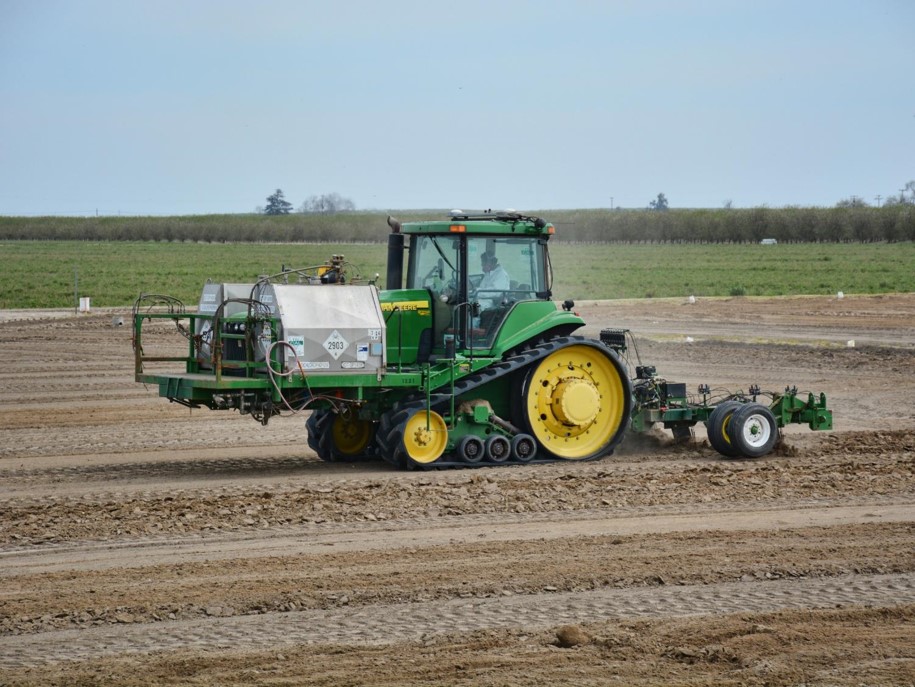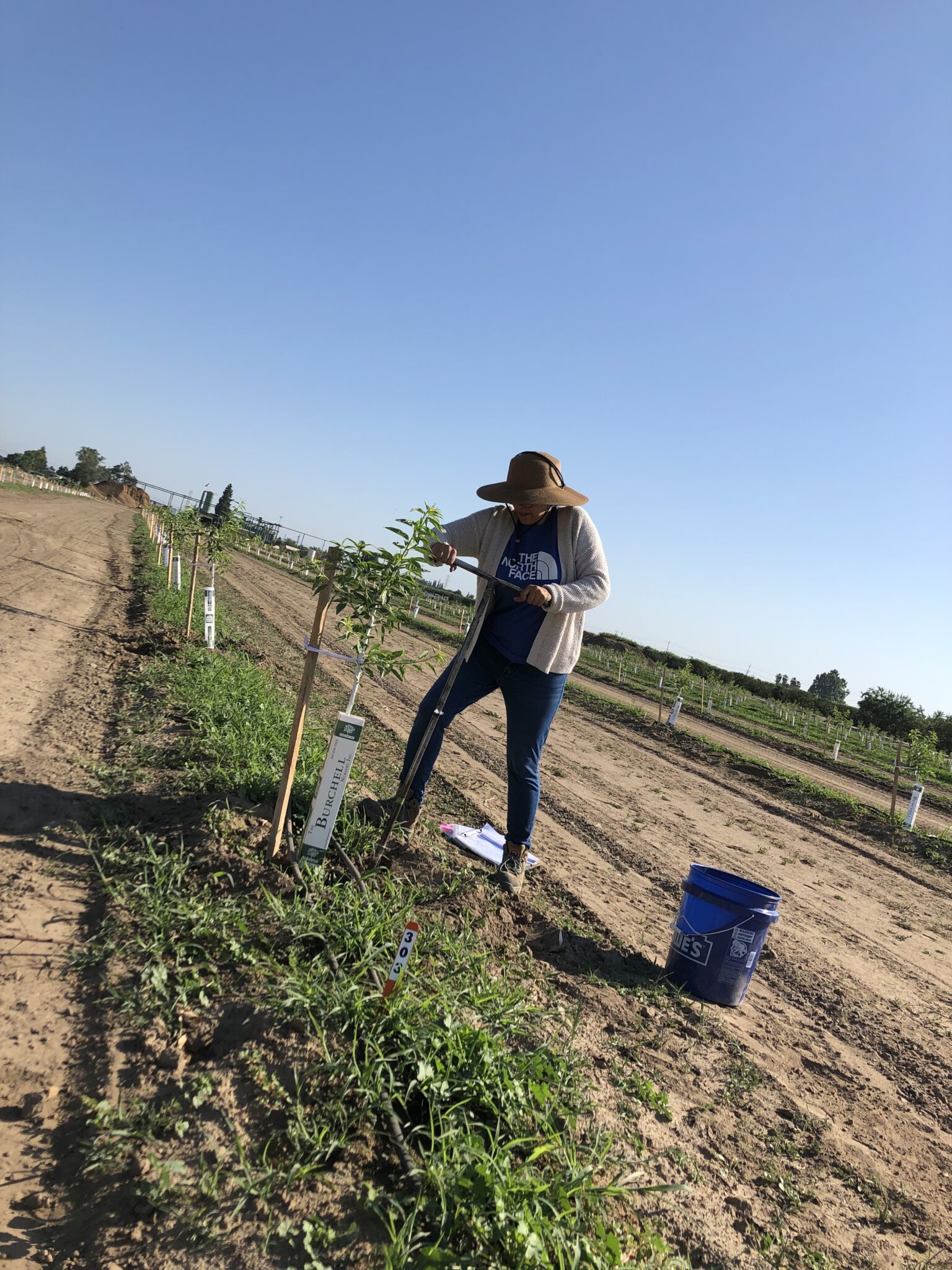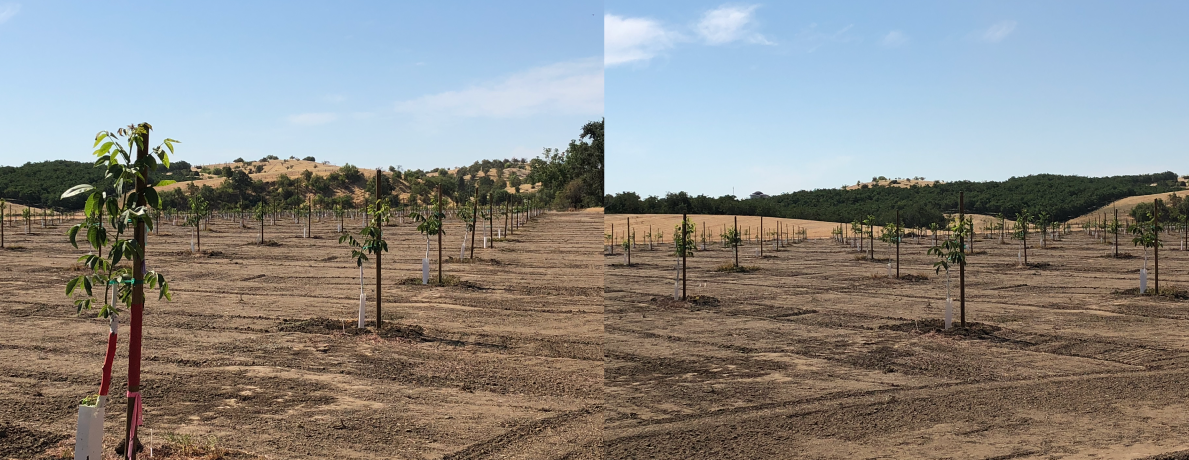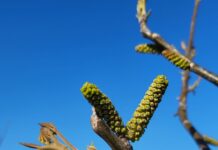
The time frame for planning a new walnut orchard can span months, if not years. From ordering trees to site preparation, growers understand the importance of preplant planning to ensure optimal orchard growth.
It is important to know the site history and soil types when planning a new orchard. If the orchard is to follow an old walnut orchard, particular attention needs to be given to the tree removal process. For successful walnut production, it is the level of damaging nematode species found in the soil that must be addressed prior to setting trees in the ground.
Fumigation and Rootstock Selection
Choosing nematode resistant or tolerant rootstocks and planning fumigation operations or other controls for nematodes plays a part in the success of a new orchard. There is active work going on in a large collaborative effort of several UC campuses, including USDA-ARS and Fresno State University, to further expand the rootstocks available for walnut production. This effort is supported by federal (USDA-NIFA), state (CDFA Specialty Crop Block Grant Program) and California Walnut Board funding.
Andreas Westphal, a UC Riverside nematology specialist based at the Kearney Agricultural Research and Extension Center (KARE) in Parlier, said that approximately 85 percent of California walnut orchards are estimated to be infested with the walnut root lesion nematode (Pratylenchus vulnus), one of the most damaging soil pests in walnut. Mature trees are less affected by this soil pest, but even at very low numbers in the soil, root lesion nematodes can inflict severe damage to young trees, invading and compromising their smaller root mass. Trees planted in root lesion nematode-infested soils can exhibit loss of vigor, stunting and unhealthy foliage.
Other nematode species that affect young walnuts grown on certain rootstocks are ring nematode and root knot nematode.

Identifying Problem Sites
Pre-plant soil sampling, appropriate treatment and vigilance, along with proper rootstock selection, are recommended to ensure trees get the best start possible and reach their production potential.
Soil sampling, whether in an existing orchard that is scheduled to be pulled out or a fallow site, requires some planning. Timing is important. It is a good idea to sample soil for nematodes when the old orchard is still in place so probable nematode infestations can be identified near the old trees.
Before the existing orchard trees are removed, sampling sites near active roots, at the edge of the tree canopy, in the wetting zone of drip emitters or the microsprinklers will yield the most representative sample where nematodes could be detected. Westphal said nematodes are easiest found in the soil where tree roots are actively growing. With this strategy, knowing where to sample soils will yield a better representation of the nematode population. Soil sampling at a dry, long-fallowed site at the wrong time of the year may not yield any live nematodes, but that does not mean they are not present, Westphal stressed. Nematodes do need live host plant roots to thrive. If there is no host present, they start to decline, unfortunately, not quick enough below damaging thresholds, but low enough that they are difficult to detect.
Take soil samples near both healthy and weak trees to compare information about the impact of existing nematodes on reducing tree growth. Sample soils in an established orchard at the 18-inch depth level. If a dry, fallow site is sampled, the soil may have to be obtained from a depth of at least 2 or 3 feet if not down to 5 feet. Nematodes tend to not be extractable from “bone-dry” soil of the top layers but may survive at greater depths where soil moisture levels are higher, and the slower drying process allows them for some adoption to the changing environment.
Once the soil samples are taken, Westphal noted that they have to be kept cool to ensure any nematodes in the sample are alive when the samples reach the laboratory. Some of the nematode extraction procedures depend on the nematodes to be alive and active. When submitting soil samples, it is very important to provide sufficient information to the diagnostic lab. General information about the field will help to choose the proper soil extraction method. Westphal said it helps to ask about the extraction method used as different species of nematodes require different extraction methods.

Control Methods
Moving forward with the results of the laboratory tests, growers can make decisions based on nematode levels, orchard soil types and rootstock selections. Fumigation or rotating in a non-host crop are options prior to replanting walnuts.
Before orchard removal, kill old tree roots as a first step toward nematode control as it speeds root breakdown. Dr. Mike McKenry, nematologist emeritus, developed methods on how to kill a tree before the trees are removed. Killing roots also kills many of the nematodes inside the roots, but may not impact nematode eggs within the tissue. This method reduces the overall load of nematode infestation in a field and potentially can help in the clean-up process.
If a potential walnut orchard site is confirmed to have root lesion nematode present in the soils, and a long wait time before planting is not feasible, fumigation is the next step.
Preparation of the soil prior to fumigation will help with efficacy. Hardpan, poor percolation, high salts and herbicide residues need to be mitigated.
There are theoretical options to forego fumigation and replant walnuts. These are time-consuming and require multiple years of non-walnut cropping. If root lesion nematodes are present, rotating to another crop, such as alfalfa, can reduce levels. Other crops that do not host walnut root lesion nematode are tomatoes, sweet corn and cucurbits. If ring nematodes are present, a year or two of sudan or a sorghum-sudan hybrid can reduce levels. Where both ring and root lesion nematodes are a problem, the alfalfa can be followed with a sudan crop.
Chemical fumigation is advised for orchard sites where high nematode counts have been found. Kristi Sanchez, nematology specialist with TriCal Diagnostics, said field preparation for fumigation is essential to the success of the operation.
Soil types will dictate the site preparation. Sanchez said heavier soils that hold moisture pose problems because if the soil moisture is too high the fumigation will not be as effective.
“This is a big factor; the soil moisture needs to be below 12%,” Sanchez said.
Preparing an orchard site also calls for deep ripping to remove all old roots from the previous orchard as they can be a source of root lesion nematode re-infection. This soil loosening to 5 or 6 feet will also increase the easily accessible soil volume for root exploration. There should be very little plant residue on the soil surface after preparation is complete.
Soil type also plays a role in the final field preparation before fumigation. Heavy soils are more likely to form clods during the tilling process and they will hold moisture and harbor root lesion nematodes. It takes extra effort to break up the clods, Sanchez said, but it will allow the fumigant to penetrate the soil. The two best options for orchards, she added, are 1,3-dichloropropene (1,3-D) in Telone II or Chloropicrin or a combination of the two.
Current Research
Westphal and UCCE advisors Katherine Jarvis-Shean, Elizabeth Fichtner and Luke Milliron are continuing research in pre- and post-plant remedies for nematode infestations in walnut orchards. The team is conducting trials in several walnut growing regions.
Westphal said that several newer nematicidal materials have shown promise in annual crop production and require implementation work in walnuts. In this California Walnut Board-supported project, a re-evaluation of current threshold levels for damage by P. vulnus is being done by exposing three rootstock genotypes to increasing population densities of nematodes in microplots. In detailed studies at KARE, three preplant treatment materials are tested and applied as soil drenches with large amounts of irrigation water. Two low-volume materials, Salibro and VelumOne, were applied in open plots through a drip irrigation system and one high-volume material was tarped during the process. These studies are currently expanded to different production areas with the help of grower collaborators.
Preliminary studies showed the materials reduced nematode population densities to the required soil depths. There is still a lot to learn about how best to use these tools. Westphal said in his research report that treatment effects were more likely to be significant after repeated growth periods that permit conversion of stress relief from nematode infection. Several growing periods of improved root growth and resulting in improved energy status of the trees have the potential to improve crop productivity.
In summary, infestations with walnut root lesion nematode require vigilance in soil testing and mitigation. Currently, emphasis is placed on the use of soil fumigants, but additional tools are in various stages of development. It is critical to be aware of potential nematode infestations before establishing an orchard. Mitigation strategies after establishment are much more challenging; so, planning and preparation is key to sustain highly productive walnut orchards.











